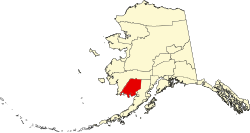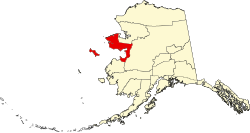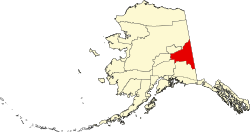Top Qs
Timeline
Chat
Perspective
Unorganized Borough, Alaska
Portions of Alaska which are not contained in any of its 19 other organized boroughs From Wikipedia, the free encyclopedia
Remove ads
The Unorganized Borough is composed of the portions of the U.S. state of Alaska which are not contained in any of its 19 organized boroughs. While referred to as the "Unorganized Borough", it is not a borough itself, as it forgoes that level of government structure. It encompasses nearly half of Alaska's land area, 323,440 square miles (837,700 km2), and, as of the 2020 U.S. census, it had a population of 77,157, which was 10.52% of the population of the state.[1] The largest communities in the Unorganized Borough are the cities of Bethel, Unalaska, and Valdez.
This article needs additional citations for verification. (December 2019) |
Remove ads
Overview
Summarize
Perspective
This vast area has no local government other than that of school districts, municipalities, and tribal village governments. Except within some incorporated cities, all government services in the Unorganized Borough, including law enforcement, are provided by the state or by a tribal government. School districts in the Unorganized Borough are operated either by cities, in those limited instances when the city has chosen to undertake those powers, or through the general guidance of the Alaska Department of Education under the auspices of Rural Education Attendance Areas.
Census areas
Unique among the United States, Alaska is not entirely subdivided into county equivalents. To facilitate census-taking in the vast unorganized area, the United States Census Bureau, in cooperation with the state, divided the unorganized borough into 11 census areas, beginning with the 1970 Census and undergoing border or name adjustments most recently in 2007, 2008, 2013, 2015, and 2019.[2]
Remove ads
History
Summarize
Perspective
This section needs additional citations for verification. (April 2023) |
During the 1950s, when the push for the territory of Alaska to become a state was at its height, any municipal government was extremely limited and scattered. Territory-wide, there were no more than a few dozen incorporated cities, and a small handful of service districts, broken into public utility districts and independent school districts. The service districts were authorized by the territorial legislature in 1935 to allow unincorporated areas limited powers to provide services and to raise taxes for them.
The United States Congress had forbidden the territory from establishing counties.[8][why?] The delegates of the convention which wrote the Alaska Constitution had, in fact, debated the merits of establishing counties, and had rejected the idea in favor of creating a system of boroughs, both organized and unorganized.
The intent of the framers of the constitution was to provide for maximum local self-government with a minimum of local government units and tax-levying jurisdictions. The minutes of the constitutional convention indicate that counties were not used as a form of local government for various reasons. The failure of some local economies to generate enough revenue to support separate counties was an important issue, as was the desire to use a model that would reflect the unique character of Alaska, provide for maximum local input, and avoid a body of county case law already in existence.
Instead, Alaska adopted boroughs as a form of regional government. This regionalization tried to avoid having a number of independent, limited-purpose governments with confusing boundaries and inefficient governmental operations, as the territorial service districts had been. The boroughs were widely seen as an important foundation for the government to provide services without becoming all-powerful and unnecessarily intrusive, an argument which surfaced time and time again during various attempts by the legislature to create organized boroughs out of portions of the unorganized borough.
Alaska adopted the borough structure by statute in 1961, and envisioned boroughs to serve as an "all-purpose" form of local government, to avoid the perceived problems of county government in the lower 48 states as well as Hawaii. According to Article X of the Alaska Constitution, areas of the state unable to support borough government were to be served by several unorganized boroughs, which were to be mechanisms for the state to regionalize services; however, separate unorganized boroughs were never created. The entire state was defined as one vast unorganized borough by the Borough Act of 1961, and over the ensuing years, Alaska's organized boroughs were carved out of it.
Alaska's first organized borough, and the only one incorporated immediately after passage of the 1961 legislation, was the Bristol Bay Borough. The pressure from residents of other areas of the state to form boroughs led to the Mandatory Borough Act of 1963, which called for all election districts in the state over a certain minimum population to incorporate as boroughs by January 1, 1964.
A resolution of the State of Alaska's Local Boundary Commission introduced in January 2009 spells this out in greater detail:
- WHEREAS, the 1963 Alaska State Legislature passed, and Governor Egan signed into law, the "Mandatory Borough Act" (Chapter 52, SLA 1963), dictating that certain regions of Alaska – those encompassing Ketchikan, Juneau, Sitka, Kodiak Island, Kenai Peninsula, Anchorage, the Matanuska-Susitna valleys, and Fairbanks – form organized boroughs by January 1, 1964.[9]
Furthermore, 21 Rural Education Attendance Areas were established by the Legislature in 1975. This created regional divisions of the unorganized borough for the purpose of establishing rural school districts. Many REAAs were later absorbed into organized boroughs.
Remove ads
Regional Educational Attendance Areas
Summarize
Perspective
There are 19 Regional Educational Attendance Areas in the unorganized borough.[10]
Remove ads
Dispute over future mandatory boroughs
A number of boroughs have been incorporated since the Mandatory Borough Act, but most (the primary examples being North Slope, Northwest Arctic, and Denali) were incorporated to exploit a significant potential source of taxation, such as natural resource extraction and tourism.[citation needed]
Many residents of the Unorganized Borough, particularly those in the larger communities which may be most susceptible to organized borough incorporation, have been opposed to such incorporation, and say the status quo suits them just fine.[citation needed]
On the other hand, many Alaskans residing in organized boroughs feel that they unfairly subsidize residents of the Unorganized Borough, especially for education. In 2003, the Alaska Division of Community Advocacy identified eight areas within the Unorganized Borough meeting standards for incorporation.[11] Bills have been introduced in the Alaska Legislature to compel these areas to incorporate, though as of 2009[update], none have been signed into law.
Remove ads
Communities
Cities
- Adak
- Akiak
- Alakanuk
- Aleknagik
- Allakaket
- Angoon
- Aniak
- Anvik
- Atka
- Bethel
- Bettles
- Brevig Mission
- Chefornak
- Chevak
- Chuathbaluk
- Clark's Point
- Coffman Cove
- Cordova
- Craig
- Delta Junction
- Dillingham
- Diomede
- Eagle
- Edna Bay
- Eek
- Ekwok
- Elim
- Emmonak
- Fort Yukon
- Galena
- Gambell
- Golovin
- Goodnews Bay
- Grayling
- Gustavus
- Holy Cross
- Hoonah
- Hooper Bay
- Hughes
- Huslia
- Hydaburg
- Kake
- Kaltag
- Kasaan
- Kotlik
- Koyuk
- Koyukuk
- Klawock
- Kwethluk
- Lower Kalskag
- Manokotak
- Marshall
- McGrath
- Mekoryuk
- Mountain Village
- Napakiak
- Napaskiak
- Nenana
- New Stuyahok
- Nightmute
- Nikolai
- Nome
- Nulato
- Nunapitchuk
- Nunam Iqua (formerly Sheldon Point)
- Pelican
- Pilot Station
- Platinum
- Port Alexander
- Quinhagak
- Ruby
- Russian Mission
- Savoonga
- Scammon Bay
- Shageluk
- Shaktoolik
- Shishmaref
- St. George
- St. Mary's
- St. Michael
- St. Paul
- Stebbins
- Tanana
- Teller
- Tenakee Springs
- Thorne Bay
- Togiak
- Toksook Bay
- Unalakleet
- Unalaska
- Upper Kalskag
- Valdez
- Wales
- Whale Pass
- White Mountain
- Whittier
Census-designated places
- Akiachak
- Alatna
- Alcan Border
- Arctic Village
- Atmautluak
- Attu Station
- Beaver
- Big Delta
- Birch Creek
- Central
- Chalkyitsik
- Chenega
- Chicken
- Chisana
- Chistochina
- Chitina
- Circle
- Copper Center
- Coldfoot
- Crooked Creek
- Deltana
- Dot Lake
- Dot Lake Village
- Dry Creek
- Eagle Village
- Eareckson Station
- Elfin Cove
- Evansville
- Flat
- Fort Greely
- Four Mile Road
- Gakona
- Game Creek
- Glennallen
- Gulkana
- Healy Lake
- Hollis
- Hyder
- Kasigluk
- Kenny Lake
- Kipnuk
- Klukwan
- Koliganek
- Kongiganak
- Kwigillingok
- Lake Minchumina
- Lime Village
- Livengood
- Manley Hot Springs
- McCarthy
- Mendeltna
- Mentasta Lake
- Mertarvik
- Metlakatla
- Minto
- Nabesna
- Naukati Bay
- New Allakaket
- Newtok
- Nelchina
- Nikolski
- Northway Junction (former)
- Northway Village (former)
- Oscarville
- Paxson
- Pitkas Point
- Point Baker
- Port Clarence
- Port Protection
- Portage Creek
- Rampart
- Red Devil
- Silver Springs
- Slana
- Sleetmute
- Stevens Village
- Stony River
- Takotna
- Tanacross
- Tatitlek
- Tazlina
- Tetlin
- Tok
- Tolsona
- Tonsina
- Tuluksak
- Tuntutuliak
- Tununak
- Twin Hills
- Venetie
- Whitestone
- Whitestone Logging Camp
- Willow Creek
- Wiseman
Unincorporated communities
- Bill Moore's Slough[12]
- Chuloonawick
- Copperville
- Crow Village
- Cube Cove
- Eyak
- Hamilton[13]
- Haycock
- Georgetown
- Napaimute
- Ohogamiut
- Solomon
- Umkumiute
- Waterfall
Indian reservation
Remove ads
See also
- Unorganized Yukon, a similar area in the neighboring Canadian territory of Yukon
References
External links
Wikiwand - on
Seamless Wikipedia browsing. On steroids.
Remove ads














